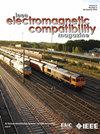金属氧化物元素非线性电阻特性的有效近似数学表达式
IF 2.5
3区 计算机科学
Q3 ENGINEERING, ELECTRICAL & ELECTRONIC
IEEE Transactions on Electromagnetic Compatibility
Pub Date : 2025-04-17
DOI:10.1109/TEMC.2025.3557030
引用次数: 0
摘要
金属氧化物压敏电阻(MOV)是由氧化锌和其他金属氧化物的混合物制成的,它的电阻或电阻率会随着外加电压或电场强度的变化而变化。通常,MOV元件的非线性电阻特性是通过对电压和电流的实验测量来确定的。本文介绍了一个由两个幂函数和一个带有五个可调系数的常数项组成的数学表达式。它被用来描述电压-电流或电场-电流密度在电流或电流密度的大范围内的特性,分别从微安到几十千安培或从几百a /m2到几百kA/m2。该表达式准确地再现了几种低压MOV元件的非线性电阻行为。提出了一种非迭代拟合方法来确定表达式的五个系数,利用积分对非线性特征进行线性化,而不需要迭代或均匀采样。通过与先前提出的表达式和实验数据的比较,表明该方法具有很高的精度。此外,在8/20微秒脉冲电流的残余电压测试中,该方法可准确估计MOV及其引线的寄生电感。本文章由计算机程序翻译,如有差异,请以英文原文为准。
An Effective Approximate Mathematical Expression for Non-Linear Resistance Characteristics of Metal Oxide Elements
A metal oxide varistor (MOV), manufactured from a blend of zinc oxide and other metal oxides, undergoes changes in resistance or resistivity depending on changes in applied voltage or electric field strength. Typically, the nonlinear resistive characteristics of MOV elements are determined through experimental measurements of voltage and current. This article introduces a mathematical expression comprising two power functions and a constant term with five adjustable coefficients. It is utilized to describe the voltage-current or electric field-current density characteristics across a wide range of current or current density, spanning from microamperes to several tens of kiloamperes or from several hundred A/m2 to a few hundred of kA/m2, respectively. This expression accurately reproduces the observed nonlinear resistive behaviors of several low-voltage MOV elements. A noniterative fitting method is developed to determine the expression's five coefficients, using integration to linearize nonlinear characteristics without requiring iterations or uniform data sampling. Through comparison with a previously proposed expression and experimental data, the proposed technique demonstrates remarkably high accuracy. Furthermore, the proposed technique is applied to accurately estimate the parasitic inductance of an MOV and its lead wires during a residual voltage test conducted with an 8/20-microsecond impulse current.
求助全文
通过发布文献求助,成功后即可免费获取论文全文。
去求助
来源期刊
CiteScore
4.80
自引率
19.00%
发文量
235
审稿时长
2.3 months
期刊介绍:
IEEE Transactions on Electromagnetic Compatibility publishes original and significant contributions related to all disciplines of electromagnetic compatibility (EMC) and relevant methods to predict, assess and prevent electromagnetic interference (EMI) and increase device/product immunity. The scope of the publication includes, but is not limited to Electromagnetic Environments; Interference Control; EMC and EMI Modeling; High Power Electromagnetics; EMC Standards, Methods of EMC Measurements; Computational Electromagnetics and Signal and Power Integrity, as applied or directly related to Electromagnetic Compatibility problems; Transmission Lines; Electrostatic Discharge and Lightning Effects; EMC in Wireless and Optical Technologies; EMC in Printed Circuit Board and System Design.

 求助内容:
求助内容: 应助结果提醒方式:
应助结果提醒方式:


